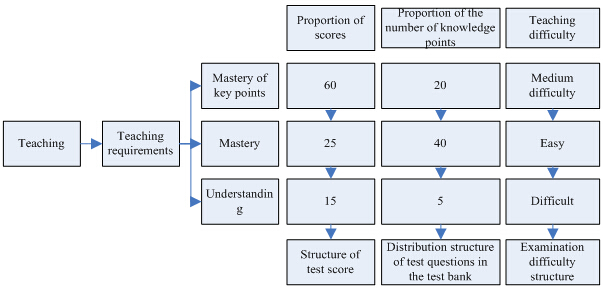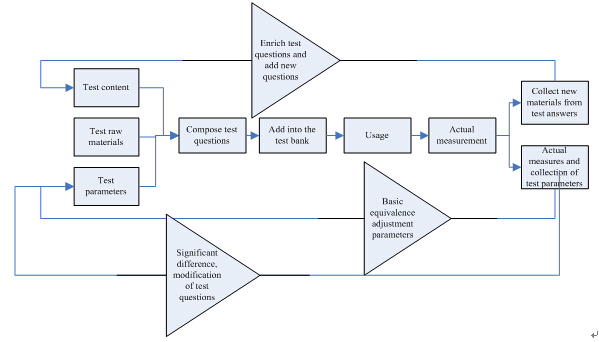1.Model proposition
There is a high demand for the tests given by the OUC. Therefore, we must make sure there are sufficient test questions. Following research on the relationship between the size of the exam system test bank and the amount of random test questions (using the combinatorial optimization method), Wang Jianzhong from Sichuan Normal University concluded that when there are 3000 test questions in the examination system, a random selection of 100 test questions has the proper rate of repetition. How can we formulate sufficient test questions? For objective questions, we should construct the questions according to the smallest knowledge point. For both subjective and objective scenario-based knowledge points, we should use a fixed model for composition and create different composition scenarios. According to the requirements of the two-way breakdown, we should first formulate a standard test model that meets proposition requirements, and formulate a number of mutually exclusive test questions by changing relevant data or conditions. This method balances the objectives and difficulties of assessment, and controls the rate of repetition.

Figure 2 Proposition model design
2. Equivalent storage
When considering the issue of loading a large number of questions onto the test bank, it is necessary to ensure that each question is treated equally. The most common method is to compare them with anchor questions before loading onto the test bank. First, we should establish standard questions and test them. Questions with the same value as the standard anchor test can be categorized and loaded onto the bank. The test bank can be enriched in this way. However, this method of test bank construction is particularly lengthy. In addition, it is necessary to find a set of candidates who are all at the same level and avoid exposing new candidates to the trial tests. In the beginning, the OUC test bank requires a large amount of questions and is under tight time constraints. In order to ensure equivalent storage, it is necessary to strictly combine the teaching outline and the proposition. The difficulty structure of the test papers should be adjusted according to the proportion of difficult points stated in the teaching outline. A test score structure should be set and selected according to the key knowledge points put forward in the teaching outline. The strategy of the examination paper should take the two-way breakdown as its major point of reference.

Figure 3 Equivalents into the Test Bank Design Map
3. Dynamic links
The test bank should be constantly updated. The dynamic linkage mechanism of the test bank has three aspects. Firstly, links between test materials. Regular research should be carried out on the answers given by students. Teachers should carefully analyze and select materials, in order to further enrich the test paper material. New materials can be added to keep the test content up to date. Second, links between test question parameters. In the initial stage of test bank construction, the parameters for all the tests are set as discreet values by the test designers. After the test questions have been in use for a certain period of time, a computer is used to automatically adjust and update the examination parameters, and provide reliable parameters for the next round of test paper extraction. Thirdly, links between test contents. A value is set for the difference between the discreet value and the actual measurement value of the test. When the value reaches a certain amount it demonstrates that the test designer needs to alert the test accordingly.

Figure 4 Dynamic linkage design map